Made in Japan: ACURA
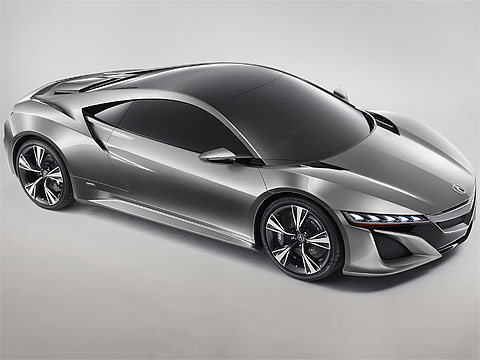

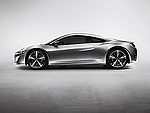



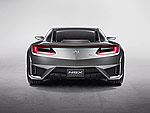
The dynamically-styled Acura NSX Concept gives an indication of the next great performance vehicle from the Acura brand. Making use of lightweight materials and a mid-mounted V6 engine, the Acura NSX Concept employs several new technologies for Acura, including application of Acura's innovative new Sport Hybrid SH-AWD® (Super Handling All Wheel Drive™) hybrid system.
Utilizing an unique 2 Electric Motor Drive Unit with a bilateral torque adjustable control system, the all-new hybrid all-wheel-drive system can instantly generate negative or positive torque to the front wheels during cornering. Acura anticipates the new Sport Hybrid SH-AWD® will deliver handling performance unmatched by previous AWD systems. In addition to the handling benefits of the Sport Hybrid SH-AWD® system, a powerful next-generation VTEC® V-6 engine with direct-injection works in concert with a dual clutch transmission with built-in electric motor to create supercar acceleration while offering outstanding efficiency.
"This Sport Hybrid SH-AWD system will make NSX the ultimate expression of Acura's idea to create synergy between man and machine," said Takanobu Ito, president and CEO of Honda Motor Co., Ltd. "The NSX will make the driver one with the car to enhance dynamic driving abilities without getting in the way."
While most supercars opt for brute force delivered from a large engine, the Acura NSX Concept champions the true racing philosophy of an extremely favorable power-to-weight ratio.
"Like the first NSX, we will again express high performance through engineering efficiency," added Ito, who led the development of Acura's first NSX supercar. "In this new era, even as we focus on the fun to drive spirit of the NSX, I think a supercar must respond positively to environmental responsibilities."
The new Acura supercar, expected to debut in the next three years, will be developed by an engineering team led by Honda R&D Americas, Inc., and manufactured in Ohio, at a yet to be named facility.
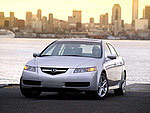








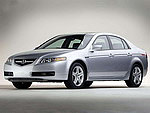
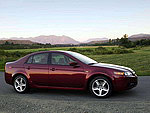

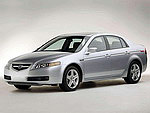



Highlights
The dramatically redesigned all-new 2004 TL features increased performance, even sportier handling and an assortment of class-leading technology. A new 3.2-liter engine delivers 270 horsepower and 238 lb-ft. of torque while lowering emissions and maintaining impressive fuel economy. The TL is now available with two transmissions, a 5-speed Sequential SportShift automatic and a new close-ratio 6-speed manual. Inside, an assortment of cutting edge electronics has been added to the TL's already impressive list of standard features. These include the first automotive application of DVD-Audio 5.1 surround sound as well as HandsFreeLink' wireless phone connectivity and XM" Satellite Radio, making the 2004 TL one of the most comprehensively equipped performance luxury sedans available. Highlights for the 2004 TL include:
Powertrain
• Engine
- Horsepower increased from 225 to 270 horsepower
- Torque increased from 216 to 238 lbs- ft
- Dual-stage intake manifold
• Available close-ratio 6-speed manual transmission
• Limited slip differential (w/6-speed manual transmission)
• Drive-by-wire throttle system
• Maintenance Minder system
• LEV-2 ULEV emissions
• High flow exhaust system
Chassis
• 4-wheel independent double wishbone suspension
• 4-channel VSA (Vehicle Stability Assist)
• 4-piston Brembo brakes (w/6-speed manual transmission)
• 17-inch wheels and tires
• Available 17-inch high performance tires (w/6-speed manual transmission)
• Refined steering system for enhanced feel and reduced kickback
• Electronic Brake Force Distribution (EBD)
• Brake Assist System
Interior
• Acura HandsFreeLink(TM) wireless phone connectivity
• Acura/ELS(R) Premium 8-speaker Surround Sound System with DVD-Audio, DTS(TM) and CD 6-disc Changer, AM/FM Tuner and Dolby(R) Cassette
• Multi-Info Display screen
• Optional Acura Navigation System with Voice Recognition(TM) featuring 8-inch display Dual-zone, Dual-mode Automatic Climate Control
• Steering-wheel mounted audio, cruise and voice recognition controls for HandsFreeLink and navigation system
• Tilt and telescopic steering wheel
• Enhanced keyless entry system with seven customizable memory functions
• 10-way power adjustable driver's seat with power lumbar support
• Power glass moonroof
• Perforated leather seating and trim
• Brushed aluminum accent trim
Body/Styling
• Dramatic new styling
• Wider, more aggressive stance
• Enhanced torsional rigidity
• Acoustic front windshield glass
• High Intensity Discharge (HID) headlights
Safety
• Front dual-stage, dual-threshold airbags
• Driver's and front passenger's side airbag
• Passenger's side airbag with occupant position sensor system
• Standard side curtain airbags
• Pedestrian Impact Protection
• Enhanced seat belt warning system
• Vehicle Stability Assist (VSA) with traction control


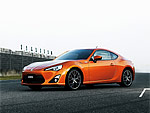


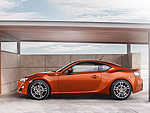



The anticipation is over: the new Toyota GT 86 sports car makes its world debut at the 2011 Tokyo motor show. The compact 2+2 model, one of the most keenly awaited new cars of the coming year, will go on sale in the UK in June 2012.
The Toyota GT 86 has been conceived as an entirely driver-focused machine, designed to deliver the core qualities of the classic sports car experience. That means precise, instant response to the smallest throttle and steering inputs and the kind of performance that appeals to those for whom driving is a passion, not a necessity.
The Toyota GT 86 is built on a new platform, with a highly aerodynamic bodyshell stretched tight over the car's mechanical elements. Rather than fitting a heavy, large capacity powertrain, Toyota has opted instead to go back to its sporting roots, installing a compact, front-mounted, free-revving petrol engine that drives the rear wheels.
This four-cylinder "boxer" unit generates 197bhp at 7,000rpm and maximum torque of 205Nm at 6,600rpm, giving the Toyota GT 86 brisk, engaging performance.
The powertrain is matched to the world's most compact four-seat design to create a car that benefits from light weight, low inertia and a low centre of gravity to achieve the best possible power-to-weight ratio. For the driver that means lively, accessible performance and dynamic character with minimal intrusion from electronic systems.
PackagingThe Toyota GT 86 measures 4,240mm long, 1,285mm high and 2,570mm wide, dimensions which make it the most compact four-seater sports car available today.
Both the powertrain and the driving position have been set as low and as far back as possible to achieve the best balance: the car has a near-perfect 53:47 front-to-rear weight distribution. The flat-four engine format and the driver's hip point - the lowest of any current Toyota production model - together give the Toyota GT 86 an ultra-low centre of gravity, at just 475mm.
The Toyota GT 86 makes the most of a light kerb weight, making it easy for drivers to exploit its nimble handling and cornering poise. The suspension features MacPherson struts at the front and double wishbones at the rear. The car rides on 17-inch wheels and is fitted with ventilated disc brakes fore and aft.
World's first horizontally opposed engine with D-4SThe Toyota GT 86's engine is the result of a joint Toyota and Subaru development programme that brings together their technical know-how and mutual passion for sports cars.
Toyota has added its D-4S injection technology to Subaru's new, horizontally opposed, naturally aspirated 1,998cc four-cylinder boxer engine. This system features separate twin injectors for both direct and port injection, and a high 12.5:1 compression ratio, increasing power and torque across a wide range of engine speeds without sacrificing fuel efficiency and environmental performance.
The flat-four engine has equal bore and stroke of 86.0mm and drives through either a six-speed manual or six-speed automatic transmission. The manual offers quick, precise shifts using a tactile, short-throw lever; the automatic transmission can be controlled using paddle shifts mounted on the steering wheel.
Power is distributed to the rear wheels via a limited slip differential to give the best possible grip in all driving conditions. The ABS and switchable vehicle stability control systems have been tuned specifically to deliver dynamic stability at the limit of the car's performance envelope with minimal electronic intervention to help preserve the purity of the driving experience.
DesignThe design of the Toyota GT 86 successfully works within the technical constraints of achieving the most compact dimensions possible, a low centre of gravity and aerodynamic performance inspired by motorsport technology, while also displaying evocative, sweeping styling that recalls Toyota's sports car heritage.
Toyota's new design language informs the styling, as in the way attention is focused on the lower part of the car with the large lower grille. Elsewhere the "keen" approach can be witnessed in the clear, expressive lines.
The lower grille's "scorpion" look gives the Toyota GT 86 a more powerful appearance, with further sporting details including the model-specific 17-inch alloy wheels, rear spoiler, twin exhausts and the "86" piston logo that denotes the car's special powertrain configuration.
On board, the ergonomics and function of every element the driver interacts with have been scrutinised to make driving the car as natural, instinctive and rewarding as possible. For example, the steering wheel has a 365mm diameter, making it the smallest ever fitted to a Toyota, and it is trimmed in buckskin, developed from exhaustive feedback from test drivers on how to achieve the best steering performance and grip.
The three-meter instrument cluster is arranged around a large tachometer, its design benefiting from close attention to the positioning of the displays, markings and typeface. The result is the best possible visibility and readability. The driver-focus of the cockpit is further reinforced by the carbon-effect trim, all-black roof lining, red stitching on the upholstery, aviation-style rocker switches and lightweight, aluminium pedals.
Toyota's 50-year sports car heritageThe Toyota GT 86 may be launched as the world's only current sports car to feature a front-mounted, horizontally opposed engine and rear-wheel drive, but it cannot claim to be the first. That honour is held by Toyota's two-cylinder boxer-engined Sports 800, which the company began developing in 1962. Since then, Toyota has established a long history of producing exciting, driver-focused sports cars with a front-engine, rear-wheel drive format that have proved as popular with the public as they have been successful in competition.
The beautiful 2000 GT, a coupe powered by a 2.0-litre straight-six engine, was first displayed at the 1965 Tokyo motor show and helped establish Toyota's global reputation as a sports car manufacturer.
Launched in 1971, the first Celica models featured rear-wheel drive powertrains and were praised by enthusiasts for their agility. All four Supra generations came with straight-six engines and rear-wheel drive, while from 1984 the MR2 won recognition as one of the best handling sports cars in motoring history.
The inspiration for the Toyota GT 86, however, is the Corolla GT (or Levin) AE86, a car with an enduring reputation for delivering sheer excitement and capturing the fundamental joy of driving. Its front-engine, rear-wheel drive package, compact dimensions, light weight, impeccable balance and superior power-to-weight ratio made it a must-have choice for rallying and circuit driving throughout its production life, from 1983 to 1987. Here in the UK the GT claimed two British Touring Car Championship titles and a series of top-level rally victories.
The Toyota GT 86 is a genuinely lightweight machine that offers the intimacy and involvement of a car that can be driven as though an extension of the driver's body. In this way, it perfectly recaptures the exhilarating spirit of the last of the AE86. And, with numerous customisable parts, its shares its predecessor's aim to be an affordable car that will evolve with its owner.

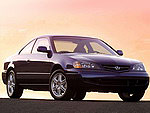




For the 2003 model year, Acura's goals for the 3.2 CL were to:
Increase performance
Update styling for a sleeker, more aggressive look
In support of those goals, the 2003 3.2 CL has received the following enhancements:
Powertrain
While it continues to come with a 5-speed Sequential SportShift automatic transmission, the CL Type-S now offers a new close ratio 6-speed manual transmission as well. Models with the new manual transmission also feature:
- Helical limited slip differential
- Curb weight of 3446 lbs. (compared to 3510 lbs. for the CL Type-S with automatic transmission)
- Multi-cone synchronizers
- Self-adjusting clutch with dual-mass flywheel
- Short-throw shift linkage
Chassis
+ CL Type-S with manual transmission replaces the VSA found in the CL Type-S with automatic transmission with new helical limited slip differential
+ New 6-spoke 16 inch wheels (3.2 CL)
+ New 6-spoke 17 inch wheels (CL Type-S)
+ CL Type-S with manual transmission adds two hydraulic engine mount dampers to counter engine movement
Body
Front Styling
+ Revised grille with body-colored surround
+ Revised headlights with black accents
Rear Styling
+ Revised taillight lenses with clear upper portion
+ New exhaust finishers
Safety/Convenience
+ OnStar(R) is standard equipment on CL models equipped with the Acura Satellite-Linked Navigation System
+ Lower Anchors and Tethers for Children (LATCH) System added on outboard rear seats for child safety seat attachment
+ Driver's Dual Stage Supplemental Restraint System (SRS)
+ Auto-up driver's side window
Interior Styling
CL Type-S
+ Models with black interiors receive titanium-look trim on doors and center console
+ In models with 6-speed manual transmission, center console redesigned to accommodate manual shifter and hand-operated parking brake
+ Perforated leather door inserts













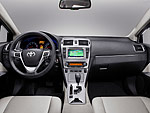
The new Toyota Avensis builds on the spaciousness, practicality and fuel efficiency of the current, third generation model.
It features a bolder and more refined exterior design, and interior improvements to finish quality, comfort and Noise, Vibration and Harshness (NVH). Driving dynamics have been enhanced, and a revised grade structure offers even greater value for money. In addition to that Toyota is introducing the Touch and Go Plus, a further advancement of its existing affordable multimedia system.
The best-selling variant of the Toyota Avensis' six engine line-up, the 2.0 D-4D turbodiesel, has been revised to deliver significant improvements in fuel consumption and CO2 emissions. With a tax threshold set at 120 g/km in almost a third of European countries, the 2.0 D-4D's 119 g/km brings generous tax benefits to both private and fleet buyers.
With a choice of two body styles, three diesel and three petrol engines, three transmissions and four model grades, the Toyota Avensis has been specifically tailored to the European market. The D-segment demonstrates a 70% focus on diesel powertrains, a 64% bias in favour of fleet sales and a preference for the wagon body style with over 50% of customers.
Designed, engineered and built in Europe, the Toyota Avensis was first launched at the end of 1997 and has since firmly established itself in the European D-segment. It sold 70,585 units throughout the region in 2010, representing a segment share of around 6%.
EXTERIOR DESIGN ? Elegance and Refinement
Both sedan and wagon versions of the Toyota Avensis are just 15 mm longer than their predecessors, but have been extensively restyled to give them a more elegant and athletic appearance.
The Toyota Avensis represents the first implementation of a new Toyota design language which is based on two key pillars: Under Priority frontal design featuring a trapezoid grille opening, which focuses attention on the lower part of the car for a distinctive, more assertive appearance, and a Keen Look approach for clear, intelligent and expressive styling.
A bolder, more refined frontal treatment features the distinctive new face of the next generation Toyota family. Key to the new Under Priority design direction is a change in the proportions of the upper and lower grilles, with the emphasis now placed on enlarging the latter for a dynamic, more aggressive look.
Beneath a wider and more powerful upper grille design, the lower bumper has been expressively sculpted with a strong, protruding centre section housing a large air intake to give the vehicle a wider stance.
In conjunction with the crisp, Keen Look detailing of integral foglamp pockets placed at the bumper extremities, the design gives the Toyota Avensis a wider, more purposeful stance and a more ground-hugging appearance.
Narrower, more expressive headlamps emphasise the sleek, elegant proportions of the new design. The new headlamps now incorporate Daytime Running Lights, strengthening the Keen Look styling of the new front treatment.
To the rear, the Toyota Avensis sedan features a newly designed rear bumper incorporating a centre guard. A new, sleeker, chromed license garnish design adds a further touch of elegance.
Using LED technology to emphasise the Avensis' Keen Look detailing, both combination lamp clusters and foglamps have been restyled for greater prominence and visibility, reinforcing the wide, stable stance of the new design.
New wheel treatments and an expanded colour range further enhance the Toyota Avensis' exterior design. 16" steel wheels feature a new cap design, whilst the existing 16" and 17" Fuji alloy wheels have been enhanced through new colour and machine facings treatment resulting in a dual-tone colour effect. The other 17" and 18" alloys also benefit from a new, darker colour treatment.
One new exterior colour has been added to the range; the standard Red being replaced by a deep, premium Dark Red which brings added maturity to the new model range.
INTERIOR DESIGN ? Sophistication and Comfort
Within a cabin already praised for its comfort, roominess and practicality, the Toyota Avensis benefits from improved perceived quality across the model range, and upgraded upholstery in a choice of new colours.
The appearance, touch and feel of the entire dashboard have been improved. The centre console layout has been redesigned to improve the switchgear layout and operability. The central air vents have been redesigned and now share the new metal paint finish of the centre console itself, and the side air vents have become chrome trimmed.
The tactile quality and feel of frequently handled parts such as the door trim gripping area, switchgear and the front console all benefit from new, higher quality ornamentation. The driver's instrument dial backlighting has been changed from amber to a higher quality white, and the rear console box lid upholstery has been changed from polyurethane to leather.
The front seatback side support shape has been redesigned for better lateral holding performance, greater comfort and reduced fatigue, and the seat upholstery has been upgraded throughout the model range.
Entry level fabric seat upholstery has been enhanced to offer higher, Sol grade trim quality, Sol grade fabric now features Executive grade trim, Executive grade fabric has been upgraded to a newly introduced Alcantara finish, and Premium grade seats are now finished with high quality perforated leather inserts for improved comfort.
Lightening the overall ambience within the Toyota Avensis' cabin, the leather upholstery is available in a choice of two new colours, Light Grey and Warm Grey in addition to the already existing Black one.
MULTIMEDIA SYSTEM ? Affordable Touch Screen Interface
The Toyota Avensis benefits from Toyota's unique range of affordable, touch-screen multimedia equipment; Toyota Touch, and the Toyota Touch & Go and Toyota Touch & Go Plus navigation systems.
Toyota Touch
Designed from scratch with all-new hardware and software, Toyota Touch is a 6.1 inch, full colour, touch screen interface which gives centralised control of numerous vehicle functions as well as connectivity to external devices such as mobile phones and portable music players.
Fitted as standard to the Toyota Avensis from Sol grade, Toyota Touch is designed to offer the widest possible range of interactive functions without the added expense of an integral satellite navigation system.
Toyota Touch & Go
Building on the Toyota Touch multimedia base unit and unique to the mainstream market, Toyota Touch & Go offers customers a full map navigation system which represents the best value for money on the market.
Available in 14 languages, Toyota Touch & Go was developed in Europe, with European customers in mind.
Considerably less expensive than traditional multimedia systems, it includes all the most popular navigation functions, such as advanced traffic coverage, and speed and safety camera warnings.
Using a compatible mobile phone, via Bluetooth, Toyota Touch & Go also offers on-board connectivity to Google Local Search -the largest and most up-to-date search database in the world.
Via Google Maps, destinations may be input remotely from home or office, and Points of Interest may be downloaded for entry as destinations.
The installation of Touch & Go also upgrades the multimedia base unit with the addition of an SMS on-screen send and receive function incorporating a contact person image display.
Several Apps are already available to download, including fuel prices, weather and parking space information.
Toyota Touch & Go has been designed specifically to be both affordable and flexible. The system can be easily updated with the newest functions, updated maps and the latest Apps, as they become available.
Toyota Touch & Go Plus
Fitted as standard to Premium grade models and making its world debut in the Toyota Avensis, Touch & Go Plus adds numerous new, advanced technology features to Toyota's remarkable touch-screen multimedia system.
It features advanced voice recognition for navigation address input, one-shot destination entry, music search and play, and phone contact search and call.
It also incorporates email send and receive, a text-to-speech message readout facility, a calendar and, through a Gracenote database, a 'Play More Like This' music function.
Enhanced satellite navigation mapping incorporates 3D city modelling and landmarks. The additional Traffic Patterns database uses the average speed on road depending on time, day and month to optimise your trip.
GRADE STRUCTURE ? Greater Quality and Value for Money
The new Avensis model range will be available in four grade levels - Avensis, Sol, Executive and Premium. Every grade has been revised to deliver greater value for money through improved levels of standard equipment and enhanced sensory quality.
Avensis Grade
The current generation Avensis' generous standard equipment specification is enhanced by the adoption of integral daytime running lights and USB connectivity. Seat upholstery quality has been upgraded by the addition of Sol grade trim, and the sensory quality of the centre console has been improved with a new, silver upper panel and matt black lower panel paint finish.
An expanded options list now features front foglamps, and a Comfort Pack which includes cruise control, a leather steering wheel and a 6-speaker CD stereo system with Bluetooth connectivity.
Sol Grade
To the enhanced Avensis grade specification, Sol grade adds Executive grade quality seat trim, an all-silver centre console paint finish and machine-faced 16" and 17" alloy wheels. The Toyota Touch Display Audio is equipped with a rear parking camera.
Options include the Touch & Go navigation system, rear parking sensors, High Intensity Discharge (HID) headlamps with an Adaptive Front Lighting System (AFS) and a panoramic roof.
Executive Grade
To the improved Sol grade standard specification, Executive grade adds a nickel and wood centre console finish, Alcantara seat trim with leather bolsters, and a new, darker coloured 17" alloy wheel finish.
Amongst the options available are an 11-speaker Display Audio system with rear parking camera, a choice of Touch & Go or Touch & Go Plus navigation systems, High Intensity Discharge (HID) headlamps with an Adaptive Front Lighting System (AFS) on 2.2 litre versions with automatic transmission and a Pre-Crash Safety (PCS) system incorporating Adaptive Cruise Control (ACC), Lane Keep Assist and Lane Departure Warning.
Premium Grade
Further augmenting the Executive grade specification, Premium grade adds perforated leather upholstery in a choice of Ice Grey, Warm Grey or Black colours. Ice Grey is combined with a bright silver centre console finish, Warm Grey and Black with a warm nickel finish.
High Intensity Discharge (HID) headlamps with an Adaptive Front Lighting System (AFS), a Touch & Go Plus navigation system, an 11-speaker Display Audio system with rear parking camera and new dark finish 18" alloy wheels are all fitted as standard.
DRIVING PERFORMANCE ? Enhanced Driving Dynamics and Improved 2.0 D-4D
Further improvements to ride comfort and driving dynamics were fundamental goals in the development of the Toyota Avensis.
The new Toyota Avensis benefits from increased body rigidity, improved aerodynamics and NVH insulation, greater seat comfort, revised front and rear suspension, and an improved Electric Power Steering (EPS) system. In combination, these engineering enhancements deliver greater ride comfort, improved handling agility, and the promise of a more engaging driving experience.
The best-selling variant of the Avensis' six engine line-up, the 2.0 D-4D turbodiesel, has been revised to deliver significant improvements in fuel consumption and CO2 emissions. This not only lowers the Total Cost of Ownership, but also -with a tax threshold set at 120 g/km in almost a third of European countries and the 2.0 D-4D generating just 119 g/km- brings generous tax benefits to both private and fleet buyers.
Increased Body Rigidity
The use of high-tensile steel in key locations throughout the bodyshell combines light weight with high structural rigidity. Spot welding points have been added to the rear door and luggage compartment openings to further enhance body rigidity and steering stability.
Enhanced Aerodynamics and Low Rolling Resistance Tyres
The comprehensive use of aerodynamics components throughout the exterior both enhances handling stability and agility and -through low drag coefficients of just Cd 0.28 for the sedan and 0.29 for the wagon- helps reduce fuel consumption and CO2 emissions.
Allied to the use of extensive underbody covers, front and rear wheel arch spats and a rear boot lip spoiler, the new Avensis benefits from the adoption of an aero-step design to the front bumper to suppress lift and turbulence. In addition, aero-stabilising fins located at the base of the A pillar and integral to the design of the new rear combination lamps help smooth the flow of air down the sides of the vehicle and away from the rear, enhancing stability.
Without sacrificing ride comfort, handling performance, noise or braking distance, both the fuel consumption and CO2 emissions performance of 2.0 D-4D versions equipped with a Diesel Particulate Filer (DPF) are further improved by the adoption of low rolling resistance tyres.
Improved Seat Comfort and NVH Insulation
Front seat comfort has been improved through a change in the shape of the seatback side support, enhancing both initial fitting comfort and lateral support when cornering.
All occupants further benefit from substantial improvements to sound insulation in the Toyota Avensis, which help to deliver a quieter, more refined cabin environment.
The shape of the dashboard inner silencer has been changed to reduce the gap and it has been extended in the transmission tunnel area, the heavy layer dash inner silencer has been extended upwards, the heavy layer floor carpet has been extended towards the inner dash silencer, and sound absorption material has been added to the fresh air duct.
This additional insulation significantly reduces noise transmission from the engine bay, most notably in conjunction with the noise reduction improvements to the turbo charger, glow control and combustion chambers of the 2.0 D-4D engine.
Revised Front and Rear Suspension
The new Avensis retains the same, proven, front McPherson strut and rear double wishbone suspension layout of its predecessor. However, both front and rear suspension systems feature significant improvements to enhance ride comfort and handling performance.
The front suspension subframe mountings have been optimised for better handling and steering feeling with increased steering response. The strut features a dual path upper support and the front shock absorber has been re-tuned, improving damping performance and ride comfort.
The double wishbone rear suspension combines a lightweight design with compact packaging to maximise luggage compartment loadspace.
The shock absorber has been re-tuned to improve ride comfort and handling performance. And the rear anti-roll bar diameter has been increased from 22 to 23 mm, enhancing body control and response to steering inputs.
Retuned Electric Power Steering System
The Toyota Avensis' Electric Power Steering has been comprehensively revised to provide sharper vehicle response, improved steering feel and a more engaging driving experience.
The steering gear ratio has been changed from 49.9 mm/rev to 54.2 mm/rev. This reduction in lock-to-lock revolutions not only provides more direct steering, but also improves agility and manoeuvrability under urban driving conditions.
The rigidity of the steering gear sub-frame mounting has been increased to improve both steering feel and vehicle response. And both the EPS Assist force and Electric Control Unit mapping have been modified to enhance steering feel and better coordinate steering input and vehicle response.
Six Engine Line-up with improved 2.0 D-4D turbodiesel
Meeting a wide range of D-segment customer needs, the new Toyota Avensis shares the six powertrain range of its predecessor; three petrol and three diesel engines offering the performance- and economy-enhancing benefits of Toyota Optimal Drive.
Toyota Optimal Drive showcases a combination of wide-ranging advanced technologies and internal improvement programmes designed to optimise the balance of performance and driving enjoyment with fuel economy and low emissions.
These diverse core technologies focus on three key aspects of powertrain development: Firstly, the reduction of powertrain weight through the use of super-lightweight and highly compact engine components and transmissions; secondly, the minimisation of mechanical losses through the reduction of friction throughout the drivetrain; and, thirdly, the maximisation of combustion efficiency.
In recognition of the diesel powertrain's dominance of the D-segment, representing over 70% of the mix, Toyota has extensively revised its 124 hp 2.0 litre D-4D turbodiesel, which is now available with a Diesel Particulate Filter (DPF) and complies with Euro 5 emissions regulation standards.
The unit features a new turbocharger with a lower friction bearing system and an electric actuator, and the torque characteristics of each gear have been adjusted. As a result, low rpm torque has increased from 234 Nm to 280 Nm at just 1,400 rpm, offering a marked improvement in higher gear throttle response.
CO2 emission-reducing lubrication and cooling circuit improvements include a 2-stage pressure oil pump with improved oil jet, an optimised water pump with a reduced flow rate, and a twin-chamber oil pan to improve engine warming speeds. Exhaust emissions are further lowered through a new glow plug control strategy and improvements to the construction and coating of the DPF.
The use of a resin cylinder head cover, oil cooler bracket and water pipe reduce engine weight by 3 kg. The reduction of friction through the adoption of a low friction vacuum pump, a low friction timing chain and low viscosity oil further enhance fuel efficiency. And combustion improvement through a new piston bowl shape and the new glow strategy has perceptibly lowered engine NVH.
Overall, the engine is quieter and torque delivery has become more linear, yet fuel efficiency has improved and CO2 emissions have been lowered by some 15% -from 139 to only 119 g/km- in both sedan and wagon versions of the new Avensis.
This marked reduction in CO2 emissions has significant Total Cost of Ownership implications. A taxation threshold of 120 g/km exists in almost a third of all European countries, and the revised 2.0 D-4D unit's 119 g/km CO2 and 4.5 l/100km average fuel consumption figures offer tax benefits for both private and fleet drivers.
In addition to the revised 124 hp 2.0 D-4D turbodiesel, the new Toyota Avensis' six powertrain range further comprises a 150 hp, 2.2 D-4D unit available with either a Diesel Particulate Filter (DPF) or a Diesel Particulate and NOx Reduction filter (DPNR), a 177 hp 2.2 D-4D DPNR variant, and a choice of 132 hp 1.6 litre, 147 hp 1.8 litre and 152 hp 2.0 litre petrol engines.
All engines are mated to 6-speed manual transmissions. The 150 hp 2.2 D-4D DPNR unit may be optionally equipped with a 6-speed automatic transmission, and both 1.8 and 2.0 litre petrol engines may be fitted with Toyota's Multidrive S continuously variable transmission with steering wheel mounted paddle shift.
Electric Parking Brake
All manual transmission versions of the Toyota Avensis feature an Electric Parking Brake (EPB). The EPB combines an existing auto release function with a new, auto apply function which engages the parking brake when the ignition is turned off.
SAFETY ? Advanced Driver Assistance Technologies
The new Avensis shares the world-class safety performance of the previous generation vehicle, which was awarded a maximum, 5-star rating in the 2009 Euro NCAP crash test programme.
Toyota is committed to providing the highest levels of active, passive and pedestrian impact safety standards, and took the lead in the development of several advanced new safety technologies such as pre-crash safety, lane departure warning and lane keeping assistance systems.
Advanced Pre-Crash Safety System
An Advanced Pre-Crash Safety (PCS) system is available as an option on Executive and Premium grade 2.2 litre D-4D 150 6-speed automatic transmission models. It employs a millimetre wave radar sensor to scan the road ahead, recognising potentially dangerous objects and assisting the driver in reducing the chances of a collision.
If there is a high possibility of a collision, PCS will alert the driver and, when he begins to brake, provide braking assistance to supplement his own braking effort, simultaneously activating the seatbelt pre-tensioners. If the driver does not brake and a collision is inevitable, the system will automatically apply the brakes to reduce impact speed.
Adaptive Cruise Control
Adaptive Cruise Control (ACC) works in tandem with the PCS system. It will automatically maintain a selected distance from the vehicle in front. Once the road ahead is clear, the Avensis automatically returns to its original cruising speed.
Lane Departure Warning and Lane Keeping Assist
Completing the advanced safety specification of the 2.2 litre D-4D 150 6-speed automatic transmission Executive and Premium grade models, PCS is further complimented by Lane Departure Warning (LDW) and Lane Keeping Assist (LKA) systems.
Using digital camera technology mounted behind the driver's rear view mirror, these systems can help to prevent unintended lane changes by first giving an audible and visual warning and then applying corrective steering torque to help the driver remain within a chosen lane.
Additional Active Safety Systems
All new Avensis versions are fitted, as standard, with an Anti-lock Braking System (ABS), Electronic Brakeforce Distribution (EBD), Brake Assist (BA), Traction Control (TRC) and Vehicle Stability Control (VSC+).
EBD works with ABS to ensure that the most effective brake force is applied to each wheel, according to road conditions. By preventing the wheels from locking, EBD helps to maintain sure-footed stability during cornering and braking.
BA identifies the need for, and applies, additional braking force if the driver fails to apply sufficient force during emergency braking, or releases brake pressure too soon.
TRC monitors and controls the amount of power that is applied to the road through the car's wheels. If the system detects that one or more wheels is about to lose traction it instantly determines the best way to restore traction to that wheel, either by decreasing the power being sent to the wheel that is about to spin or, in more extreme cases, momentarily braking the wheel until it regains traction.
VSC+ is designed to prevent loss of car control when entering a corner too fast or in slippery conditions which might lead to a skid. Via sensors monitoring car body rotation, wheel speed and brake pressure, the system assesses vehicle stability and the proximity of either an understeer or oversteer slide.
The system restores stability by automatically adjusting engine output and applying smoothly modulated braking to the appropriate wheel individually, and by providing assist torque through the Electric Power Steering (EPS) to help the driver make the correct inputs to restore vehicle stability.
Adaptive Front Lighting
New Avensis model equipped with High Intensity Discharge (HID) headlamps are fitted with an Adaptive Front Lighting System (AFS). Calculating where the vehicle will be in three seconds time according to steering operation and vehicle speed, the system swivels the low beam projector headlamps in response to steering input, helping to illuminate a bend as the driver steers into it.
AFS is also equipped with a dynamic levelling function, which automatically maintains a constant beam height. The combination of these two functions achieves optimum light distribution in all driving conditions.